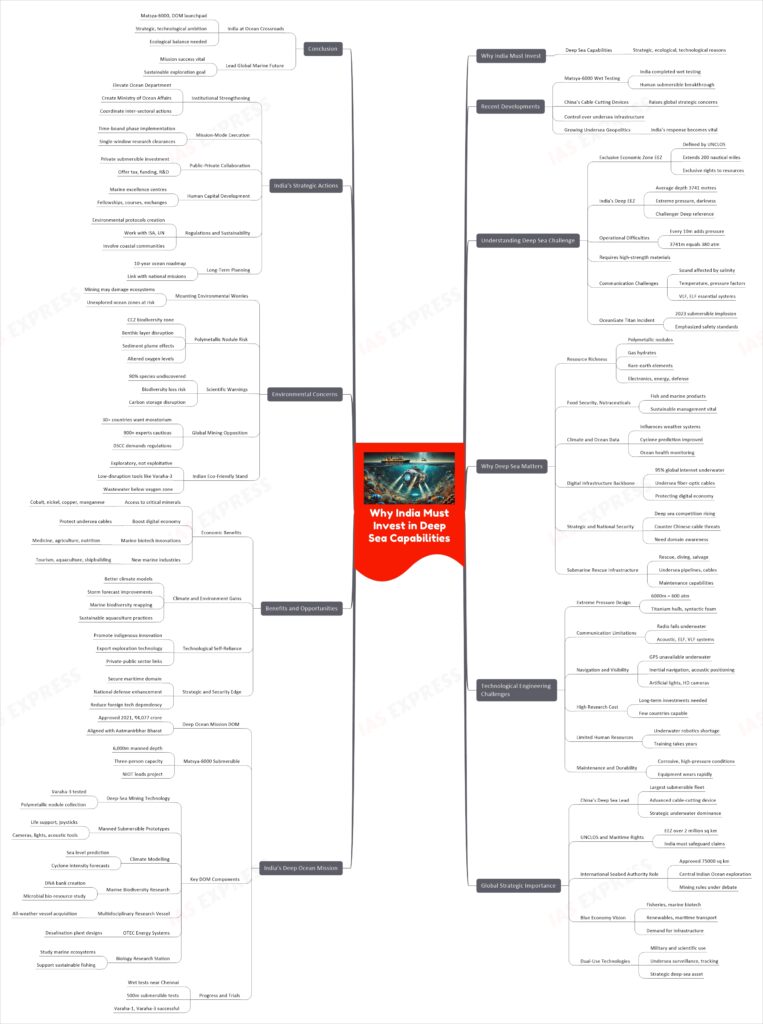India’s Deep Ocean Mission Explained: Goals, Technology, and Challenges

From Current Affairs Notes for UPSC » Editorials & In-depths » This topic
IAS EXPRESS Vs UPSC Prelims 2024: 85+ questions reflected
With India recently completing the wet testing of its Matsya-6000 submersible, a breakthrough in deep-ocean exploration, the nation is gearing up to join a select league of countries capable of sending humans to extreme ocean depths. This achievement comes at a time when China has unveiled advanced underwater cable-cutting devices, raising global concerns over the strategic control of undersea infrastructure. As geopolitical interests expand below the surface, India’s focus on deep sea capabilities is no longer optional—it is vital.

Understanding the Deep Sea Challenge
- The Exclusive Economic Zone (EEZ) of a country, as defined by the United Nations Convention on the Law of the Sea (UNCLOS), stretches up to 200 nautical miles (about 370 km) from its coastline. Within this zone, the country has exclusive rights to resources, both living and non-living.
- India’s EEZ is vast, but its average depth is 3,741 metres—a realm marked by extreme pressure, darkness, and harsh conditions. While this is significant, it remains shallower than the Challenger Deep in the Mariana Trench, which reaches more than 10 km below sea level.
- Operating at these depths is extremely difficult. Every 10 metres adds one atmosphere (atm) of pressure, so at 3,741 metres, the pressure exceeds 380 atm. That’s 380 times the pressure we experience at sea level. This means that any submersible or equipment operating here needs to be constructed with high-strength materials that won’t collapse under pressure.
- Communication underwater is another hurdle. Unlike in air, sound propagation in water is affected by factors like salinity, temperature, and pressure. Very Low Frequency (VLF) and Extremely Low Frequency (ELF) systems are essential for undersea communication but are expensive and technologically complex.
- These challenges were tragically highlighted in 2023 by the implosion of the OceanGate Titan submersible, reinforcing the need for meticulous safety and design standards in deep-sea missions.
Why Deep Sea Capabilities Matter for India
- Resource Richness: The ocean holds massive reserves of polymetallic nodules, gas hydrates, oil, and rare-earth elements. These are vital for electronics, energy, and defense technologies. With proper technology, India can tap into these treasures to meet industrial and strategic needs.
- Food Security and Nutraceuticals: The ocean is also a key source of fish and marine-based health products. Sustainable marine resource management is crucial to ensuring food security for millions.
- Oceanographic and Climate Data: The deep ocean influences climate patterns and weather systems. Exploring it can improve climate modelling, cyclone prediction, and ocean health monitoring, making India better prepared for environmental challenges.
- Digital Infrastructure and Economic Backbone: Over 95% of global internet traffic is routed through undersea fiber-optic cables. These cables are the backbone of the digital economy, enabling everything from video calls to stock trading. Protecting and expanding this network is crucial for India’s digital future.
- Strategic and National Security: As seen in China’s recent development of a deep-sea cable-cutting device, deep oceans are increasingly becoming zones of strategic competition. India needs to prepare for possible threats by building strong domain awareness and the ability to deploy countermeasures underwater.
- Submarine Rescue and Underwater Infrastructure: In addition to exploration, India needs capabilities for submarine rescue, diving operations, and salvage. It must also be able to lay and maintain underwater oil pipelines, communication cables, and mining systems.
Technological and Engineering Challenges in Deep Sea Exploration
- Extreme Pressure: The deeper we go, the stronger the pressure. At 6,000 metres, where India’s Matsya-6000 aims to reach, the pressure is nearly 600 times that at sea level. Engineering submersibles that can survive such pressure requires titanium hulls, syntactic foams, and advanced materials.
- Communication Limitations: Conventional communication methods do not work underwater. Radio waves dissipate quickly in water, so acoustic technologies like sonar and ELF/VLF systems must be used. These are expensive and still under development in many parts of the world.
- Navigation and Visibility: GPS does not work in deep oceans. Submersibles must rely on acoustic positioning and inertial navigation systems. Moreover, sunlight cannot penetrate beyond 200 metres, so artificial lighting and high-definition cameras are essential for any visual work.
- High Cost of Research and Development: Deep-sea missions require long-term financial investments in research, human resources, testing, and manufacturing. Only a few countries, like China, USA, Russia, France, Japan, and South Korea, have developed full-fledged deep-sea programs.
- Limited Human Resource and Skill Base: India lacks a sufficiently skilled workforce trained in underwater robotics, submersible operations, and marine biology. Developing this talent pool requires specialized institutions and years of training.
- Maintenance and Durability: The salty, high-pressure, corrosive environment of the deep sea wears out equipment rapidly. Ensuring long-term durability and functionality of machinery is both complex and expensive.
Strategic Importance in the Global Context
- China’s Lead in Deep Sea Dominance: China currently operates the largest fleet of submersibles in the world. It recently revealed a cable-cutting device that can threaten vital global communication links, underlining the military and strategic significance of underwater technologies.
- UNCLOS and India’s Maritime Rights: Under the United Nations Convention on the Law of the Sea (UNCLOS), India has the right to explore and use resources within its EEZ, which spans over 2 million square kilometres. India must act fast to enforce and safeguard its maritime claims.
- Role of the International Seabed Authority (ISA): India has received approval to explore 75,000 sq. km in the Central Indian Ocean for polymetallic nodules. But global rules for commercial deep-sea mining are still under debate. India must stay ahead diplomatically and technologically to secure its interests.
- Blue Economy Vision: The deep sea is key to India’s Blue Economy, which includes fisheries, marine biotechnology, renewable energy, and maritime transport. Realising this vision requires exploration backed by solid infrastructure, legal frameworks, and global cooperation.
- Dual-Use Nature of Technology: Technologies developed for exploration can also be used for military surveillance, submarine tracking, and undersea warfare. This dual-use nature means that deep ocean capability is a strategic asset, not just a scientific one.
India’s Deep Ocean Mission: Vision and Components
- The Deep Ocean Mission (DOM), approved in 2021 with a budget of ₹4,077 crore, aims to explore the deep sea for sustainable use of its resources. It aligns with India’s Aatmanirbhar Bharat initiative, emphasizing indigenous technology.
- One of the mission’s centrepieces is the Matsya-6000, a manned submersible designed to carry three people up to 6,000 metres below sea level. The National Institute of Ocean Technology (NIOT) is leading this project under the Ministry of Earth Sciences.
- Key Components of DOM:
- Development of Deep-Sea Mining Technologies: Tools like Varaha-3, already tested in the Andaman Sea, are being designed to collect polymetallic nodules in challenging terrains.
- Design of Manned Submersibles and Underwater Robotics: Prototypes like Matsya-6000 include life support systems, navigation joysticks, cameras, lights, and acoustic communication tools.
- Climate Modelling and Ocean Forecasting: DOM supports the development of models to predict sea level changes, cyclone intensity, and ocean currents.
- Marine Biodiversity Research: Systematic sampling is being done to create a DNA bank of deep-sea species and explore microbial bio-resources.
- Multidisciplinary Research Vessel: India plans to acquire a dedicated all-weather vessel for operations in the Indian Ocean.
- Ocean Thermal Energy Conversion (OTEC): Designs for offshore desalination plants using ocean energy are also part of the mission.
- Marine Biology Research Station: A high-tech station for studying marine ecosystems is being developed to support biotechnology and sustainable fishing.
- Progress and Trials:
- Wet testing of Matsya-6000 has already been conducted, including manned dives at shallow depths near Chennai.
- Submersible tests at 500 metres will soon lead to full deployment by 2026.
- Equipment like Varaha-1 and Varaha-3 have already shown success in collecting polymetallic nodules from different sea zones.
Benefits and Opportunities from Deep Sea Investments
- Economic Benefits:
- Access to critical minerals like cobalt, nickel, copper, and manganese which are essential for battery production, renewable energy, and electronic devices.
- Boost to India’s digital economy by protecting and expanding undersea cable infrastructure.
- Expansion of marine biotechnology, leading to innovations in medicine, agriculture, and nutrition.
- Development of marine tourism, shipbuilding, aquaculture, and renewable ocean energy industries.
- Environmental and Climate Gains:
- Improved climate models and storm forecasts, vital for disaster management and coastal resilience.
- Enhanced marine biodiversity conservation through mapping and research.
- More sustainable fishing and aquaculture practices informed by real-time ocean data.
- Technological Self-Reliance:
- Promotion of indigenous innovation through collaboration between government institutions, universities, and the private sector.
- Opportunities to become a global exporter of deep-sea exploration tools, underwater robotics, and ocean energy solutions.
- Strategic and Security Edge:
- Ability to monitor and secure India’s maritime domain more effectively.
- Development of dual-use capabilities for national defense and underwater surveillance.
- Reduced dependence on foreign technologies for key marine operations.
Environmental Concerns and Global Opposition to Deep Sea Mining
- As deep-sea exploration progresses, so do concerns about its environmental impact. Critics warn that mining the ocean floor could damage fragile ecosystems, some of which remain entirely unexplored.
- Polymetallic nodules, a major target of deep-sea mining, are often found in biodiversity-rich zones like the Clarion-Clipperton Zone (CCZ) in the Pacific. Mining here can:
- Disrupt the benthic layer where unique species live.
- Cause noise pollution and sediment plumes that impact marine life.
- Alter oxygen levels in the water column, potentially harming marine mammals.
- Recent studies published in respected journals like Nature Geoscience and Current Biology have shown that:
- Over 90% of species in some deep-sea regions remain undescribed.
- Mining could lead to irreversible loss of biodiversity.
- The carbon storage function of ocean sediments may be affected, with implications for climate regulation.
- Global Opposition:
- More than 30 countries, including Germany and France, have called for a moratorium on deep-sea mining.
- Over 900 scientists and marine experts have signed statements urging caution and deeper study before commercial operations begin.
- Groups like the Deep Sea Conservation Coalition (DSCC) are advocating for stricter regulations through the International Seabed Authority (ISA).
- Despite these concerns, Indian scientists and planners argue that:
- Current Indian efforts are exploratory, not exploitative.
- Technologies like Varaha-3 are designed to minimize ecological disruption, using soft collection tools and controlled operations.
- Wastewater discharge, a major issue, is planned to be done below the oxygen minimum zone, to reduce impact on marine fauna.
The Road Ahead: What India Must Do
To ensure that its deep ocean ambitions are sustainable, strategic, and successful, India needs to focus on several key actions:
- Institutional Strengthening:
- Upgrade the Department of Ocean Development to a full-fledged Ministry of Ocean Affairs, with a cabinet-level minister.
- Create a central, empowered body to coordinate all ocean-related initiatives, including defense, communication, science, and environment.
- Mission-Mode Execution:
- All projects under the Deep Ocean Mission should be executed in time-bound phases.
- Promote a “single window” clearance for research and exploration to ensure faster progress.
- Public-Private Collaboration:
- Encourage private sector participation in submersible development, cable laying, and data analytics.
- Offer tax incentives, funding grants, and research collaborations to start-ups and marine tech firms.
- Investment in Human Capital:
- Establish centres of excellence in marine sciences at IITs and research institutes.
- Launch dedicated fellowships, marine engineering courses, and international exchange programs.
- Regulatory Framework and Sustainability:
- Create strict environmental assessment protocols before any commercial exploitation begins.
- Work closely with ISA and UN bodies to develop a sustainable model of deep-sea resource usage.
- Incorporate indigenous coastal communities into planning and benefit-sharing to ensure equity.
- Long-Term Planning:
- Develop a 10-year national roadmap for deep ocean science, with clear milestones in research, mining, infrastructure, and environmental goals.
- Align the mission with India’s broader goals, such as Gaganyaan, Blue Economy development, and Aatmanirbhar Bharat.
Conclusion
As global attention shifts from land and air to the mysteries of the deep sea, India stands at a turning point. With initiatives like the Deep Ocean Mission and innovations such as Matsya-6000, the country is poised to harness the ocean’s hidden treasures. But this journey requires balanced progress, where technological ambition, strategic interest, and ecological responsibility walk hand in hand. Done right, India’s deep-sea quest could not only fuel its economy but also place it among the global leaders in marine science and sustainability.
Practice Question
Analyse the ethical and ecological concerns surrounding deep-sea mining and suggest a balanced policy approach for India. (250 words)
If you like this post, please share your feedback in the comments section below so that we will upload more posts like this.

